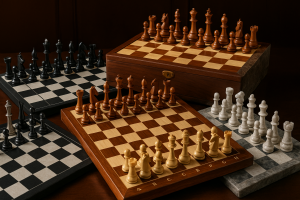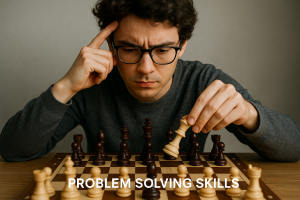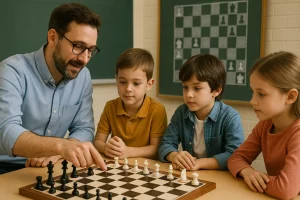Chess notation is the language of chess. It’s how players record their games, analyze positions, and communicate ideas. For hardcore chess players, mastering chess notation isn’t just a skill—it’s a necessity. Whether you’re studying grandmaster games, analyzing your own play, or preparing for a tournament, understanding chess notation is essential.
In this blog, we’ll explore the importance of chess notation, how to use it effectively, and why it’s a critical tool for improving your game. Plus, if you’re ready to take your chess skills to the next level, visit CircleChess. Our platform offers AI-powered coaching, interactive tools, and elite training programs to help you master every aspect of chess, including notation.
Why Chess Notation Matters

Chess notation is more than just a way to record moves—it’s a gateway to deeper understanding and improvement. Here’s why it’s so important:
1. Game Analysis and Improvement
Recording your games allows you to review and analyze them later. By studying your moves, you can identify mistakes, spot patterns, and learn from your experiences.
2. Studying Grandmaster Games
Chess notation is used to document famous games played by grandmasters. By studying these games, you can learn advanced strategies, tactics, and positional ideas.
3. Tournament Preparation
In official tournaments, players are required to record their moves using chess notation. Familiarity with notation ensures you’re prepared for competitive play.
4. Communication and Sharing
Chess notation allows players to share games, puzzles, and analysis with others. It’s a universal language that connects chess enthusiasts worldwide.
Types of Chess Notation
There are two main types of chess notation: Algebraic Notation and Descriptive Notation. Algebraic Notation is the most widely used today, so we’ll focus on it in this guide.
How to Use Algebraic Notation
Algebraic Notation is simple, concise, and easy to learn. Here’s a step-by-step guide to understanding and using it:
1. Understanding the Chessboard
- The chessboard is an 8×8 grid with files (columns) labeled a to h and ranks (rows) numbered 1 to 8.
- Each square is identified by its file letter and rank number (e.g., e4, c6).
2. Recording Moves
- Pieces: Each piece is represented by a letter:
- K for King
- Q for Queen
- R for Rook
- B for Bishop
- N for Knight
- Pawns are represented by the absence of a letter (e.g., e4 means a pawn moves to e4).
- Moves: A move is recorded by the piece’s letter (if applicable) followed by the destination square (e.g., Nf3 means a knight moves to f3).
3. Special Symbols
- Capture: An x is used to indicate a capture (e.g., Bxf7 means a bishop captures a piece on f7).
- Check: A + is added to indicate a check (e.g., Qh5+ means the queen moves to h5 and puts the opponent’s king in check).
- Checkmate: A # is used to indicate checkmate (e.g., Qh7# means the queen moves to h7 and delivers checkmate).
- Castling: O-O for kingside castling and O-O-O for queenside castling.
- Promotion: An = is used to indicate promotion (e.g., e8=Q means a pawn promotes to a queen on e8).
4. Ambiguity Resolution
If two pieces of the same type can move to the same square, the file or rank of the moving piece is added for clarity (e.g., Nbd2 means the knight on the b-file moves to d2).
Practical Examples of Chess Notation
Let’s look at a few examples to see how chess notation works in practice:
Example 1: Opening Moves
- e4 e5
- White moves a pawn to e4, and Black responds by moving a pawn to e5.
- Nf3 Nc6
- White develops the knight to f3, and Black develops the knight to c6.
Example 2: Tactical Sequence
- e4 e5
- Nf3 Nc6
- Bb5 a6
- Ba4 Nf6
- O-O Be7
- Re1 b5
- Bb3 O-O
- c3 d6
- h3 Na5
- Bc2 c5
- d4 Qc7
- Nbd2 cxd4
- cxd4 Nc6
- Nb3 Nb4
- Bb1 Bb7
- Re2 Rac8
- a3 Nc6
- d5 Nb8
- Nbd2 exd4
- Nxd4 Nxd4
- Qxd4 c5
- Qd3 Rfe8
- Bf4 Qb6
- Rad1 Qxb2
- Rb1 Qxa3
- Rxb5 Qa4
- Rxb7 Qxc2
- Qxc2 Rxc2
- Rxe7 Rxe7
- Bxd6 Rd8
- Bxe7 Rxd1+
- Kh2 Rd2
- Bxf7+ Kf8
- Bg6 hxg6
- f4 Ke7
- e5 Kf8
- f5 gxf5
- e6 Kg8
- e7 Kf7
- e8=Q+ Kg7
- Qe5+ Kh7
- Qxf5+ Kg7
- Qf6+ Kh7
- Qf7#
Tips for Mastering Chess Notation

- Practice Regularly
The more you use chess notation, the more natural it will become. Try recording your games or analyzing grandmaster games using notation. - Use Chess Software
Platforms like CircleChess allow you to input moves using notation and analyze them with AI-powered tools. - Study Annotated Games
Annotated games provide explanations and insights alongside the notation, helping you understand the reasoning behind each move. - Play Over-the-Board (OTB) Chess
Recording your moves during OTB games reinforces your understanding of notation and prepares you for tournament play.
How CircleChess Helps You Master Chess Notation
At CircleChess, we understand the importance of chess notation in improving your game. Our platform offers:
- AI-Powered Analysis: Input your games using notation and get detailed feedback on your moves.
- Interactive Tools: Practice puzzles and exercises that reinforce your understanding of notation.
- Elite Coaching: Learn from world-class coaches who use notation to explain advanced strategies and tactics.
Conclusion
Chess notation is an essential skill for any serious player. It allows you to record, analyze, and share games, deepening your understanding of chess and accelerating your improvement. Whether you’re a beginner or a seasoned player, mastering notation will take your game to the next level.
If you’re ready to improve your chess skills and master notation, visit CircleChess. Our platform offers everything you need to become a stronger, more confident player.














